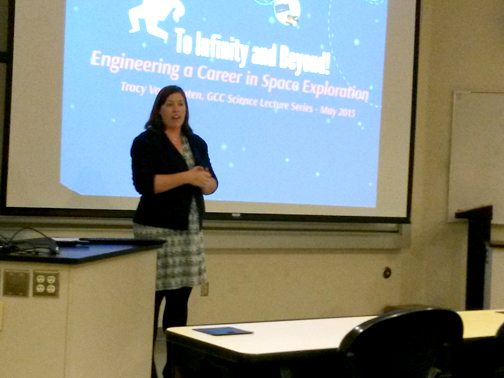
By Isiah REYES
On the 64th birthday of pioneering physicist and astronaut Sally Ride, JPL Aerospace Systems Engineer Tracy Van Houten spoke about the continuing issues facing women who pursue careers in science and mathematics.
Van Houten’s talk, “To Infinity and Beyond!” was the last of Glendale Community College’s science lectures for the spring semester, held at GCC’s Cimmarusti Science Center.
Van Houten has been a systems engineer at JPL since 2004 and among the projects she has worked on are the Mars Science Laboratory Curiosity rover mission, the Soil Moisture Active Passive project and the Europa Jupiter System Mission. Van Houten is currently the Verification and Validation lead for the Mars 2020 rover mission’s flight system.
Despite her accomplishments, she has found that success has been far less common for other women in the engineering field, who are often met with discouragement in a male-dominated workplace.
Van Houten said her goal upon first arriving at JPL was to someday be the first female director of JPL and the first female NASA administrator, goals she still has “in the back of my head.”
However, those positions have yet to be filled by women, a scenario “that leaves us engineers a little bit in the lurch because we’re still a long way off.”
Van Houten detailed her interest in science from a young age, questioning the limits of infinity at 5 years old to her experiences in high school in a pre-engineering and design class, where she and the other students designed cars.
Van Houten did not find much interest in cars, but said that the class helped her recognize an affinity for engineering.
“I really loved the process of it, but I didn’t like the problem we were solving, because I just didn’t care about designing cars. But I realized that I really liked the design process,” said Van Houten, a realization which lead her to pursue Aerospace Engineering.
At Cal Poly San Luis Obispo, Van Houten said her presidency of the Society of Women Engineers and her stint as project manager for the design of probes that would go to Venus helped her develop leadership skills, skills which netted her a much sought-after position at JPL.
“I wanted to be in a place that was all about pushing the boundaries of space exploration,” said Van Houten.
Though she loves her work, Van Houten is aware of the pitfalls facing women in order to enter STEM (Science, Technology, Engineering and Math) fields and the subsequent pitfalls even after securing a job.
“Women actually leave engineering at two times the rate of men. Nationally, we’re at about 11% of women in engineering overall,” said Van Houten. “I started at JPL with five other women. I’m the only one left. All of them went on to pursue different careers in more creative fields and they weren’t given the support that they needed to stick around. It wasn’t that they weren’t performing well at all.”
Van Houten said she observed similar occurrences in her college engineering classes, where a number of women either dropped out or changed majors.
She has also often been the sole woman on a number of projects and recalled occasions when she and other women were assigned tasks seemingly more suited for women.
“Women are often given duties in Operations. Apparently women are really good at planning for our vehicles,” said Van Houten. “I’ve been asked frequently to do secretarial type duties. So often even if I’m not the most junior person in the room, but I’m the only woman in the room, it happens all the time. ‘Oh, Tracy, can you take the notes?’”
Van Houten said women are also given party planner duties for any social functions at the workplace
“If there’s a team social event, a happy hour, we’re naturally the ones pegged. It’s hard to say no to doing those things because we’re trying to be responsive to our managers and bosses.”
Van Houten said as a child she even received negative reactions from some family members regarding attending a four-year university and pursuing a science degree, even from her grandmother, whom she considered “one of the most strong, independent women I’ve ever known.”
“Her reaction was ‘women don’t do that,’” Van Houten recalled.
Keeping girls engaged in science and math and changing workplace policies were key to changing the current mindset and increasing the level of encouragement given to young women and girls who want to pursue those jobs.
Van Houten also suggested that “reframing the problem” could encourage more women to enter the field, presenting science as a means to solving the world’s problems.
She used the example of Engineers Without Borders, an organization for students which uses engineering solutions to aid disadvantaged communities. Van Houten said women made up 54% of the organization.
“It’s about reframing the problem and understanding what engineering does to benefit society, because women care about that.”
Van Houten said that changing attitudes regarding women was important both for gender equality and for resolving the current dearth of engineers overall.
“Our country has a dramatic need for engineers right now,” said Van Houten. “Of the available STEM-related jobs in technology and engineering, we’ll only have the graduates to fill half of them.”
